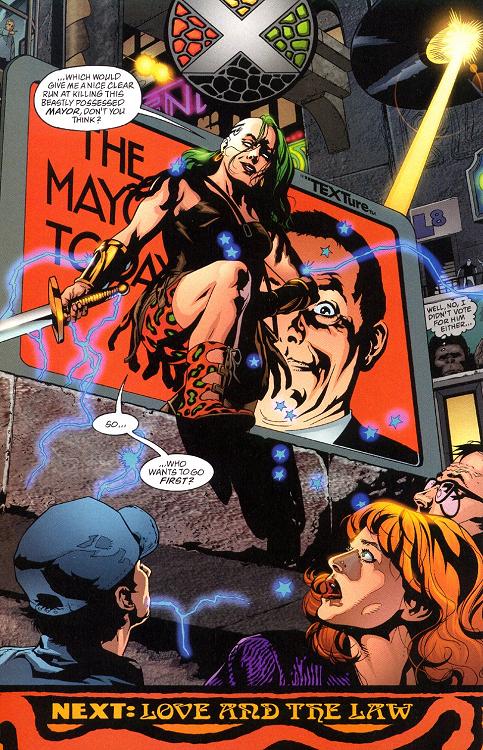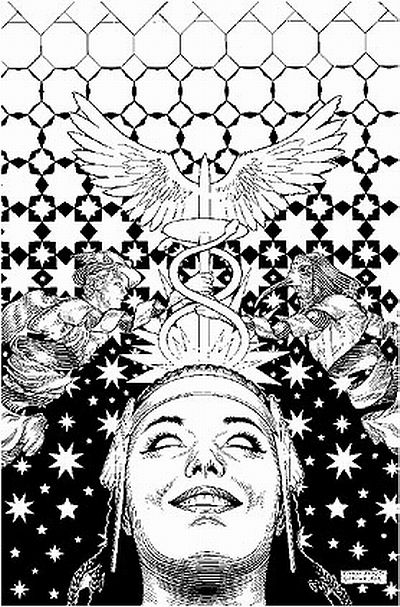

NOTE: The entire graphic of this Issue before they were colorized by Jeremy Cox used to be here but they seem to have been removed :-(.


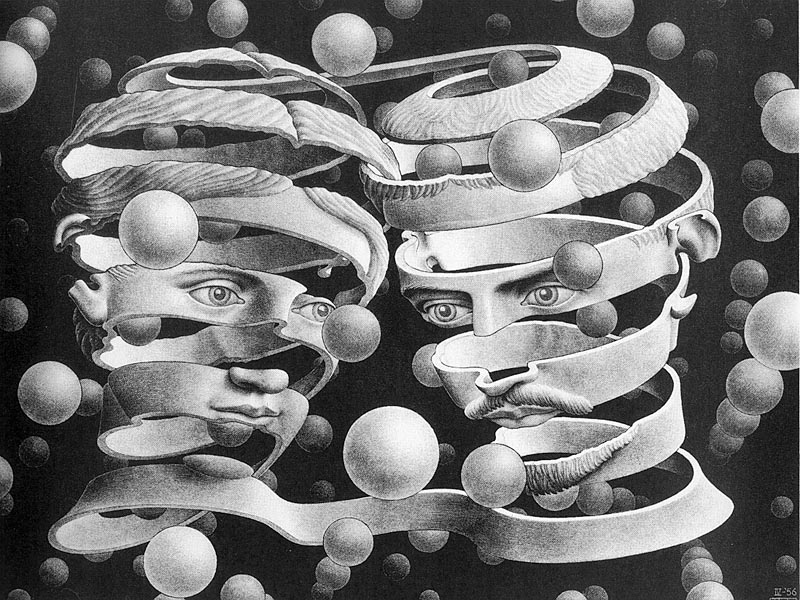
Bond of Union
TITLE:
Mercury rising is an astrological term, if you have Mercury rising it means the planet Mercury was rising on the Eastern horizon when you were born. Hermes is Mercury, messenger of the gods, a "language-god" as he's called in this Issue. The phrase is used in order to introduce the character of Mercury.
Another reference is to an increase in temperature. Here is some information from NASA about the astronomy of the planet Mercury rising in the sky.
Mercury Rising is also the name of a website dedicated to Sting which seems to have become defunct, a Bruce Willis movie and a type of wine.
I doubt whether Alan Moore meant a reference to any of the latter 3.
SYNOPSIS
The Stacia/Grace Brannagh version of Promethea manages to destroy Jellyhead a new villain whilst in Hod Prometheas (5) and (6) get trapped on a Moebius strip and meet up with a giant Hermes who explains about chess, mathematics and language. He takes them to meet Aleister Crowley, Austin Osman Spare and John Dee. Spare accompanies them for a short distance.
Back in our world Promethea has overcome the entire Evil 8 and threatens to kill the possessed mayor.
QUOTES:
“I figure, if the Painted Doll’s really dead this time, New York’s got a science-villain opening.” – Jellyhead, pg 1
“I’m running things now, and just between us, I’ve a teensy bit of a temper.” – Promethea 2(b), pg 3
“We’re in the mercurial realm of language, magic and intellect” – Promethea(6), pg 4
“I guess that telling stories with pictures is the first kind of written language.” – Promethea(6)
“Heh. Probably that’s why Promehtea’s mostly appeared in comic books this last century. Gods used to be in tapestries, but now they’re in strips.” – Barbara(5), pg. 5
“…language, it shapes our whole consciousness, how we put ideas together. Even our concepts of time. Before we had command of language, we couldn’t record events in the past…”- Promethea(6)
“Yeah, well, an eloquent never forgets.” – Promethea(5), pg. 5
“That must be one of those neural pathways you hear about.” – Promethea(6)
“Yeah and I guess those are logic gates.” – Promethea(5), pg 6
“…all this math and language and reason…why do I feel there’s something behind it that’s so intricate, it’s insane?” – Promethea(5)
“I guess it’s where genius shades into madness.” – Promethea(6), pgs 8-9
“…a loop in space I can understand…but a loop through time, that’s like infinity. That means it goes on forever.” – Barbara(5), pg 9
“I’m suddenly getting the notion that it’s what thoughts and ideas are made from. It’s ideoplasm or something.” – Promethea(6), pg 10
“Well, well. The Promethea idea. I had you in …what? The fifth century? I must say you’ve taken your time getting here.” – Hermes Trismegistus, pg 12
“I think introductions are in order…though there’s seldom order in introductions.” – Hermes Trismegisuts, pg 14
“Hod’s where all the form seen in the lower spheres of dream and matter has its origins. All perceivable form is made from this quicksilver stuff. We call it language.” – Thoth, pg 15
“…that doesn’t matter here. It’s all a story, isn’t it? It’s all fiction. All language. It can change like quicksilver.” – Hermes Trismegistus, pg. 17
“Real life. Now there’s a fiction for you! What’s it made from? Memories? Impressions? A sequence of pictures, a scattering of half-recalled words…Disjointed hieroglyphic comic strips. Unwinding in our recollection…language.” – Hermes Trismegistus, pg 17
“Mathematics is a language, a human invention, a fiction…and yet it creates such elegant form. It creates splendor. It creates truth.” – Hermes Trismegistus, pg 17
“What could be more appropriate than for a language-god to manifest through the original pictographic form of language.” – Hermes
“Uhh..so like what are you saying?” – Promethea(6)
“What am I saying? I’m saying some fictions might have a real god hiding beneath the surface of the page. I’m saying some fictions might be alive…That’s what I’m saying.” – Hermes, pgs 16-17
“Knowing your tastes, I imagine ‘mine’ would be the younger of these divinely escorted ladies?” – Crowley, pg 19
“I wonder would it distress you greatly if I kissed your behind?” – Crowley, pg 19
“That’s just Crowley’s way. Sometimes even I can’t stand the chap. He does a lot of it to irritate Dee of course.” – Spare, pg 20
“I was a bloody good artist. Better magician, mind you.” – Spare, pg. 20
“They’re always falling. That’s the lightning-struck tower. It’s the symbol of this 27th path. It’s every tower man or woman ever built.. a building, a marriage, a career…that was meant to reach heaven. The lightning is what teaches us humility.” – Spare, pgs 20-21
“Half paralyzed or not, I was still the best bloody magician in London. And bugger Crowley if he says otherwise. No, on second thoughts don’t , just to spite him.” – Spare, pg 21
NOTES & ANNOTATIONS
First the Barbelith Underground commentary on this issue
Hod
Reality Creator Workbook Series

Page 1: Our introduction to Jellyhead as the new science villain. Statue on left hand side outside main panels is reminiscent of similar ones seen in Top Ten.
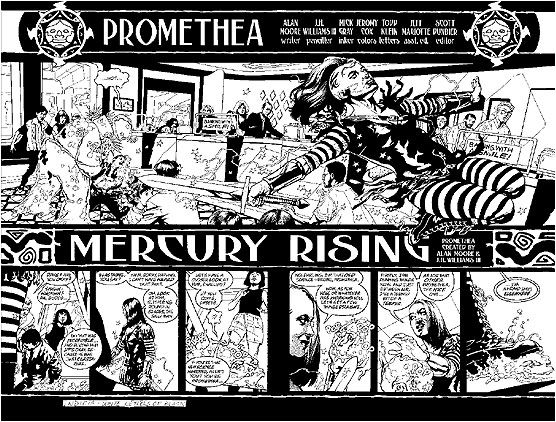
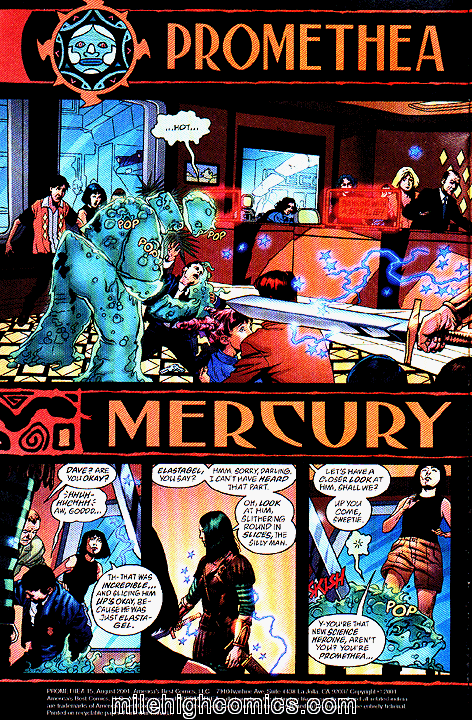
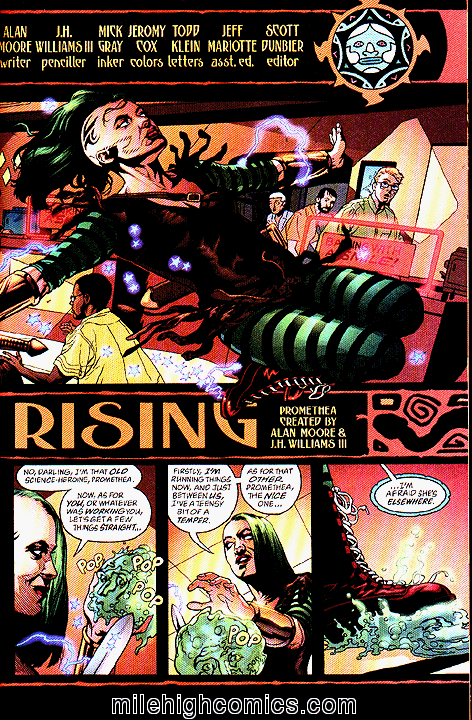
Pages 2-3 top panel: Banking with a smile - a suitably ironic motto.
Note sun symbols and snakes outside main panels.
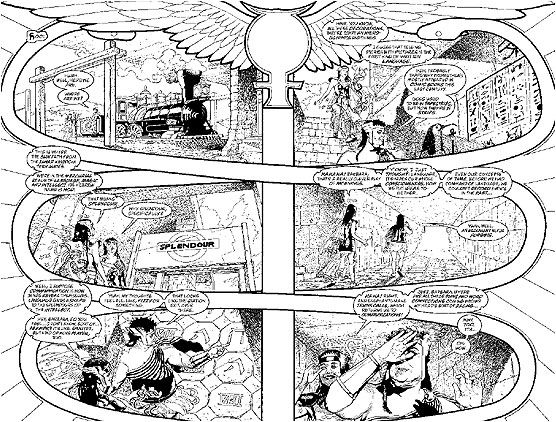
Pages 4-5: Caduceus and snakes provide a nice frame for the panels.
Page 4 Panel 3: Note Roman numeral for 8 (VIII) on the floor.
Page 5 Panel 1: Thoth visible on the wall next to all the hieroglyphics. Note Egyptian eye just above hieroglyphics.
Pages 6-7 top panel: Magic square visible between two arches.
Magic Square of 8. An 8 by 8 grid where the rows and columns all add up to 260.
According to JHW3 this is the full version of the magic square:
Yes that is a real magic square that Alan came up with. Even though we can't see it in it's entire form because of layout and perspective and shadow the numbers go like this....

Mandrake definition from the Hyperdictionary:
(Bot.) A low plant ({Mandragora officinarum}) of the Nightshade family, having a fleshy root, often forked, and supposed to resemble a man. It was therefore supposed to have animal life, and to cry out when pulled up. All parts of the plant are strongly narcotic. It is found in the Mediterranean region.
We actually have a 1694 edition of this book in the Rare Books section of the library where I work. The full catalogue title is:
Mandragorias, seu, Historia shahiludii : viz. ejusdem origo, antiquitas, ususque per totum Orientem celeberrimus : speciatim prout usurpatur apud Arabes, Persas, Indos, & Chinenses, cum harum gentium schematibus variis & curios, & militum lusilium figuris inusitatis, in Occidente hactenùs ignotis : additis omnium nominibus in dictarum gentium linguis, cum Sericis characteribus & eorundem interpretationibus & sonis genuinis : de ludis Orientalium libri primi pars prima, quae est Latina : accedunt de eodem Rabbi Abraham Abben-Ezrae elegans poëma rythmicum : R. Bonsenior Abben-Jachiae facunda oratio prosaïca : liber Deliciae regum prosâ, stylo puriore, per innominatum : de ludis Orientalium libri primi pars 2da, quae est Hebraïca / horis succisivis olim congessit Thomas Hyde ... ; praemittuntur de shahiludio prolegomena curiosa, & materiarum elenchus. Published Oxonii : E. theatro Sheldoniano, 1694.
Here is a translation of the Latin titles from TL
Quatuor evangelia et aCTa apostolorum lingua Malaica, caracterIbus Europaeis (= The four gospels and the Acts of the Apostles in Malayan language, 1677); EpisTola de mensuris et ponderibus serum sive sinensium (Letters about the measures and weights of the Seri or Chinese, 1688), appended to Bernard’s DE mensuris et ponderibus antiquis (about old measures and weights); Abraham Peritsol(i or -is, genetive) -itinera mundi (A. Peritsol's ways/travels of the world, 1691); and DE ludis orientalibus libri II (two books on oriental plays, 1694).
Mandragorias, seu, Historia shahiludii :
The Mandragoriad or History of the Chess game, (the termination -ias, -iadis, f., usually designates an epic poem, like "Ilias" = the epic poem on Ilion (Troy), or "The Dunciad" (Alexander Pope, 1724) = The poem on Dunce)
viz. ejusdem origo, antiquitas, ususque per totum Orientem celeberrimus :
that is to say its origin, age and use, most famous throughout the whole orient
especially speciatim prout usurpatur apud Arabes, Persas, Indos, & Chinenses, cum harum gentium schematibus variis & curiIs, & militum lusilium figuris inusitatis, in Occidente hactenùs ignotis :
especially as it is exercised by the Arabs, Persians, Indians and Chinese, with the various and curious (latin text must be "curiis", it's an Ablative) figures of those peoples, and with unusual figures of the game-warriors which are unknown in the West until now:
additis omnium nominibus in dictarum gentium linguis, cum Sericis characteribus & eorundem interpretationibus & sonis genuinis :
together with the names of all (figures), in the languages of the foresaid peoples, with Chineses characters and the translation of the same, and with the true pronounciation:
de ludis Orientalium libri primi pars prima, quae est Latina :
first part of the first book about the games of the Orientals, which is in Latin
accedunt de eodem Rabbi Abraham Abben-Ezrae elegans poëma rythmicum :
followed by an elegant rythmical poem of Rabbi A.A-Ezrae about the same subjcet:
R. Bonsenior Abben-Jachiae facunda oratio prosaïca :
an eloquent speech in prose by R. Bonsenior Abben-Jachia,
liber Deliciae regum prosâ, stylo puriore, per innominatum :
the book "the pleasures of the kings" in prose, in a very pure style, by an unknown author:
de ludis Orientalium libri primi pars 2da, quae est Hebraïca /
second part of the first book about the games of the Orientals, in Hebrew/
horis succisivis olim congessit Thomas Hyde ... ; praemittuntur de shahiludio prolegomena curiosa, & materiarum elenchus.
once collected in successive hours by Th. Hyde; foregoing curious prolegomena on the chess game and a table of contents. Published at Oxford by Sheldon 1694.
Published Oxonii : E. theatro Sheldoniano, 1694.
Pages 8-9:

Compare these pages to the following Escher print:

Note that the top half of these pages has daytime with the sun and clouds whilst the bottom half has nighttime with the moon and stars. The pyramids and pillars on the top half are reflected in the bottom half. A face carved on one the right hand side of this Moebius strip is actually a Pharaoh with a caduceus on his brow.
Thanks to
Claire Jordan for pointing this out.
Here are 3 different pages on how to create a möbious strip
One
Two
Three
The lazy 8 figure it makes is also known as a lemniscate and is the mathematical symbol for infinity.
These pages contain:
14 conversation bubbles right way up
8 upside down
1 sideways
Making 23 bubbles in all.
Page 10 Panel 3:
It's what thoughts and ideas are made of Ideoplasm.
Ideoplasm - Another term for ectoplasm, a substance claimed to issue from the body of a materialization medium in a vaporous or solid form, taking on the appearance of phantom forms or limbs.The concept of ideoplasm stems from the investigations of such physical researchers as the Frenchman Gustav Geley and conveys the additional idea that the substance may be molded by the operators into any shape to express the idea of the medium or of the sitters.
The following quote comes from a Rick Veitch interview
"Alan had actually worked out a terminology. He saw ideas being made of stuff called 'ideoplasm'. And he had a name for the dimension it inhabited, Ideaspace. He came to it because he was teaching himself the disciplines of magic: kabbalah and European traditions of consciousness, referred to as magic. It was just a way of exploring these levels beyond time and space."
Pages 12-13 top panel: Compare this with the following Escher print:

for anyone interested in Escher I can recommend the following CD-Rom:

Pages 14-15 top panel:
A cynocephalus is a type of baboon. Here are some pictures.
Claire Jordan notes that it is incorrectly drawn.
Thoth's cynocephalus is drawn as if it was an ape
with a
dog's head. In fact - as is clear from Egyptian images and mummies of
the
beast - it was a hamadryas baboon.
See this image for comparison:
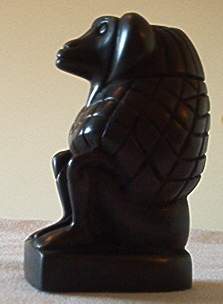
A couple of quotes about the cynocephalus
Cynocephalus (Gr.). The Egyptian Hapi. There was a notable difference between the ape-headed gods and the "Cynocephalus" (Simia hamadryas), a dog-headed baboon from upper Egypt. The latter, whose sacred city was Hermopolis, was sacred to the lunar deities and Thoth-Hermes, hence an emblem of secret wisdom-as was Hanuman, the monkey-god of India, and later, the elephant-headed Ganesha. The mission of the Cynocephalus was to show the way for the Dead to the Seat of Judgment and Osiris, whereas the ape-gods were all phallic. They are almost invariably found in a crouching posture, holding on one hand the outa (the eye of Horus), and in the other the sexual cross. Isis is seen sometimes riding on an ape, to designate the fall of divine nature into generation.
Source
Manly Hall's words are relevant to an interpretation of the companionship of fool and dog. "Cynocephalus, the dog-headed ape," he writes, "was the Egyptian hieroglyphic symbol of writing, and was closely associated with Thoth. Mercury rules the astrological Third House of writing and communication. Cynocephalus is symbolic of the moon and Thoth of the planet Mercury. Because of the ancient belief that the moon followed Mercury about the heavens, the dog-ape was described as the faithful companion of Thoth."
Source
Page 15, Panel 1: From TL:
Information source
Wotan
The chief divinity of the Norse pantheon, the foremost of the Aesir. Odin is a son of Bor and Bestla. He is called Alfadir, Allfather, for he is indeed father of the gods. With Frigg he is the father of Balder, Hod, and Hermod. He fathered Thor on the goddess Jord; and the giantess Grid became the mother of Vidar.
Odin is a god of war and death, but also the god of poetry and wisdom. He hung for nine days, pierced by his own spear, on the world tree. Here he learned nine powerful songs, and eighteen runes. Odin can make the dead speak to question the wisest amongst them. His hall in Asgard is Valaskjalf ("shelf of the slain") where his throne Hlidskjalf is located. From this throne he observes all that happens in the nine worlds. The tidings are brought to him by his two raven Huginn and Muninn. He also resides in Valhalla, where the slain warriors are taken.
Odin's attributes are the spear Gungnir, which never misses its target, the ring Draupnir, from which every ninth night eight new rings appear, and his eight-footed steed Sleipnir. He is accompanied by the wolves Freki and Geri, to whom he gives his food for he himself consumes nothing but wine. Odin has only one eye, which blazes like the sun. His other eye he traded for a drink from the Well of Wisdom, and gained immense knowledge.
On the day of the final battle, Odin will be killed by the wolf Fenrir. He is also called Othinn, Wodan and Wotan. Some of the aliases he uses to travel icognito among mortals are Vak and Valtam. Wednesday is named after him (Wodan)."
The form Odin is Scandinavian, in Germany he was called Wotan, Wodan or Woden. He's mentionned first in Tacitus' "Germania" where he is equalled to Mercury.
I think Wotan looks a little bit like Hitler!
Some esoteric (non nazi) literature on Wotan/Odin: Freya Aswynn, Leaves of Yggdrasil: A synthesis of runes, gods, magic, feminine mysteries and folklore, 1990;
Jan Fries: Helrunar, A manual of rune magic 1997
Ralph Metzner: The well of remembrance. rediscovering the Earth Wisdom Myths of Northern Europa, 2001.
Hanuman: some information about Hanuman.
Monkey Business is the name of a Marx Brothers film.
Mercury: Information about the God Mercury.
Page 16 Panel 4: The Knight’s Tour is a legitimate chess exercise.
Pages 18-19 Top Panel: Here we see
John Dee…Austin Osman Spare and Aleister Crowley.
Spare only gets a small mention in Lawrence Sutin's biography of Crowley Do What Thou Wilt:
"...the esoteric thinker and artist Austin Osman Spare, whose brilliant draftsmanship and disturbing sexuality make him one of the most unique creative figures of the century. Spare joined [Crowley's AA] in July 1910, though his tenure in the A A was brief; he was not, by nature, suited to be a disciple Crowley admired Spare highly, both as a writer on magic and as an artist, and solicited illustrations from Spare for The Equinox; there was, however, some fractious haggling (conducted through Fuller) over Spare's fee. For whatever reasons, Spare ultimately spurned Crowley both as a teacher and as a prospective friend. Nonetheless, one of Spare's drawings, presumably paid for, hung prominently in Crowley's Equinox offices."
(pg. 207)
The only other mention of Spare occurs on page 406 in a remark made by Kenneth Grant.
As Grant later admitted, "I was beginning to realize that Crowley's demands were unending. As Austin Spare frequently observed:'Enough is too much!'"
Note on Crowley and chess:
Crowley was also active in the university Chess Club. In his freshman year, he promptly triumphed over its president. It was then arranged for him to play H.E. Atkins, who would go on to become the seven-time amateur champion of England. Atkins trounced him, and Crowley had a for the first time encountered his decisive better at chess. Undeterred, Crowley went on to devote two hours a day to the game by his second year at Cambridge. His frank ambition was to become a world champion. But during the long vacation of 1897, Crowley visited Berlin while a major chess conference was underway. The sight of his ultimate ambition promptly cured him of it:
‘I had hardly entered the room where the masters were playing when I was seized with what may justly be described as a mystical experience. I seemed to be looking on at the tournament from outside myself. I saw the masters-one shabby and blear-eyed; another, in badly fitting would-be respectable shoddy; a third, a mere parody of humanity, and so on for the rest. These were the people to whose ranks I was seeking admission. ‘There, but for the grace of God, goes Aleister Crowley,’ I exclaimed to myself with disgust, and then and there I registered a vow never to play another serious game of chess.
Do What Thou Wilt : A Life of Aleister Crowley by Lawrence Sutin pgs 36-37
An article entitled Aleister Crowley: A Life in Chess by CP Ravilious can be found in the British periodical Chess Monthly (December 1997, volume 62 no 9)
Note that Spare has visual images floating around him and Dee has letters of the Enochian alphabet floating around him.
Nice effect of the sky and stars reversing colors from left to right.
Page 18, panel 2 and page 19, top panel: Note that in
the top panel Crowley has no rook amongs his pieces and that in the lower panel
he does.
I asked JHW3 about this and his reply was as
follows:
Actually the word balloon is covering up some of Crowley's chess
pieces and in the bottom panel some of the pieces are mis-colored. In that
bottom panel the angle has changed slightly enough to not see pieces Crowley has
entirely but some of Spare's pieces are colored as if they were Crowley's. Oops.
Good eye. I never even noticed before that they were colored incorrectly. Oh
well.
So there's one mystery solved. I was hoping it would have something to
do with the lightning struck tower on pg. 20 panel 3.
Crowley had a good reputation as a chess player. If you want to see for yourself the score for a game he played in 1894 can be found here. Scroll down to the 4th game.
Page 20 Panel 1: Engravings of Doctor John Dee
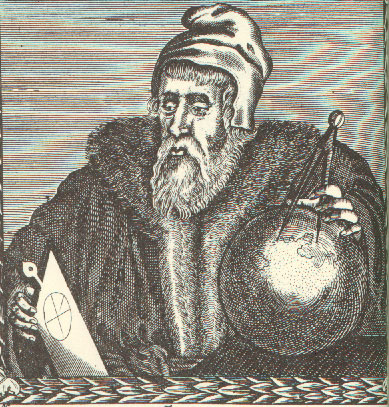
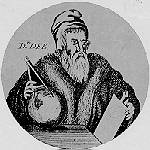

Pages 20 and 21: Note that the middle panels have the sephiroth of the Kabbalah's tree of life set out in white and black.
Page 21: The Green sun that makes it's first appearance here will be seen again in the next issue.
Page 21 Panels 1-2: The planet that looks like it's hitting the tower appears to be Mars
Page 21 Panel 3: Not sure what those red wolves are supposed to be.
Claire Jordan writes
the "red wolves" may possibly be intended as dholes, Kipling's "Red Dog," since in the story of that name the red dogs are bringers of war - though real dholes are ginger rather than deep red. See Dhole
.
Pages 22-23: Sun and snakes appears outside panels again.
Top Panel: Moore's House of Magic appears once more. Not so sure what Ego, RAYD and CUD and L32 are meant to mean though.
Middle Panel:
Entire Evil 8 have only existed 2 weeks
But only 6 of them are named here.
